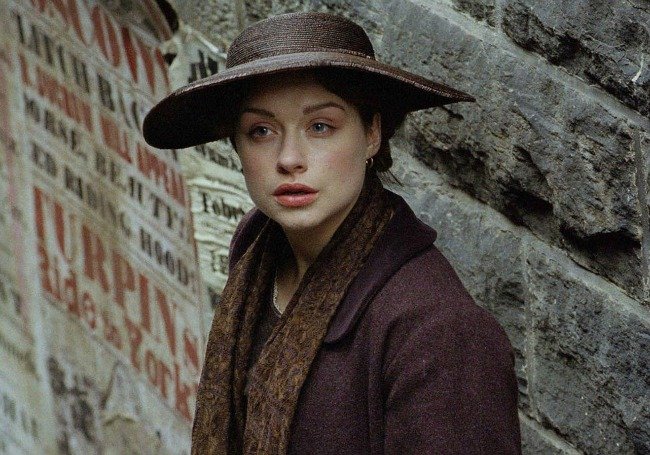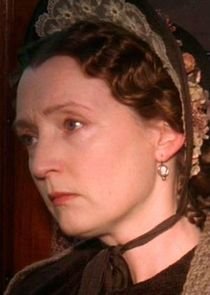Easter bonnet season upon us, so let’s talk about feminine headwear in North and South, both in the book and in the BBC miniseries.
Bonnets in the Novel
The first mention of a bonnet in Gaskell’s book concerns our little rebel, Margaret Hale, who has taken her bonnet off.
Henry: “What is this hanging from the branch of the tree? Not a bird’s nest, surely.”
Margaret: “Oh no! that is my bonnet. I never can draw with my bonnet on; it makes my head so hot.”
Apparently, she can’t be bothered with the bonnet when it’s uncomfortable. And that’s not the only time she takes her bonnet off when it’s in the way. After she sends Thornton down to speak to the rioters, she tears off her bonnet so that she can hear what he is saying outside.
There’s every indication in the novel that Margaret does follow the proper custom of the day in wearing a bonnet whenever she goes out. Gaskell describes her hastily putting on her bonnet and her shawl before going to see Bessy in Milton. Even Bessy and Mary wear one.
Did you know that the first time John Thornton ever sees her, Margaret is wearing a straw bonnet with white ribbon? This surprised me. I’ve read their first meeting scene many times, but somehow I didn’t remember that she was wearing a bonnet!
The most memorable section in the book regarding bonnet wearing is when Henry discerns something new and vibrant in Margaret towards the end of the story. This is after Margaret has spent several days at the ocean’s edge silently contemplating all that has happened to her. It’s at the seaside that she makes a courageous resolution to make the best of her future.
“The sea has done Miss Hale an immense deal of good, I should fancy,” said he, when she first left the room after his arrival in their family circle. “She looks ten years younger than she did in Harley Street.”
“That’s the bonnet I got her!” said Edith, triumphantly. “ I knew it would suit her the moment I saw it.”
“I beg your pardon,” said Mr. Lennox, in the half-contemptuous, half-indulgent tone he generally used to Edith. “But I believe I know the difference between the charms of a dress and the charms of a woman. No mere bonnet would have made Miss Hale’s eyes so lustrous and yet so soft, or her lips so ripe and red - and her face altogether so full of peace and light….”
Good for Henry for seeing the renewed spark in Margaret! (Negative points for Edith.)
Bonnets in the Film
When we think of Margaret Hale, most of us envision her the way she is shown in the BBC’s most recent film adaptation, with that wide-brimmed brown hat.
Margaret’s trademark brown frisbee hat.
Instead of a bonnet, Margaret is seen in her everyday hat throughout most of the story. It’s not hard to surmise why this was done. Bonnets make women look diminutive to the modern viewer. Although stylish and beautiful, they represent an era when women were believed to be the weaker sex—a time when women had a great many limits placed upon them.
Margaret Hale of the film wears a hat to look more modern and independent, as director Brian Percival admits. The hat allows a freer, more open view of her face. Wearing a hat also often sets Margaret Hale apart from the surrounding characters. The decision to generally keep bonnets off of Margaret was a good one. Wearing a hat instead of a bonnet lends a sense of strength and freedom to her walking about Milton.
The primary time we see Margaret in a bonnet is when she is in a state of mourning, when it’s appropriate for her to appear weaker or subdued. (Film quiz: does Margaret appear in a bonnet in any non-mourning scenes?)
Speaking of appearing strong or weak, it’s significant that although Mrs. Hale and Aunt Shaw are shown wearing traditional lace caps inside as married women, we never see Hannah Thornton wearing a lace frippery on HER stern head! (Incidentally, Edith should be wearing a lace cap as well - but perhaps the film director considered lace caps too matronly for the young and spritely Edith.)
Of course Fanny, Edith, and Ann Latimer all wear bonnets when out in the world. Well maybe not always a bonnet. Strangely enough, Ann is shown wearing a hat twice instead of a bonnet. Maybe she is copying Margaret to get John’s attention!
(Film quiz: When is the other time Ann is shown wearing a hat?)
Fanny, like Edith, loves to think of fashion. Although Fanny resisted John’s insistence on visiting the Hales, her mood was soothed by the opportunity to wear a fetching bonnet. Here is Fanny in her hideous plaid dress, performing her famous wiggle to adjust the hoops of her skirt.
Maria Hale is also concerned about fashion. She doesn’t go to Edith’s wedding because she couldn’t afford a better dress to wear. We see Maria mostly indoors, especially as she becomes an invalid. But here is her lace and flowers bonnet that she wore on her arrival to hell… er…I mean Milton.
In that opening scene of the Hales’ arrival in Milton we also see Dixon wearing a drab, colorless bonnet. She is the only working class woman to be shown wearing a bonnet. Bessy and Mary don’t wear any head coverings in the film, and neither do most of the factory girls. Bonnet strings would be a danger in the mill.
Now look at what we have here! Who noticed that the tense “street meet” scene had a haberdashery display window in the background?! Certainly not I—my attention was always on the pain etched on Thornton’s face as well as on the dagger looks thrown between Ann and Margaret.
Compared to the well-dressed Ann, Margaret looks particularly plain. For display and style, John should definitely choose finishing school Ann. The banker’s daughter is good for financial connections too, right?
I hope this blog post has made you curious enough about bonnets and hats to want to go watch the miniseries all over again! I think I may indulge as well; it’s been over two years since I’ve watched it.
Here’s a final film quiz for you:
What are the four scenes where Hannah Thornton is shown wearing a bonnet?
Now you’ll really have to go watch it! Let me know what I might have missed.







